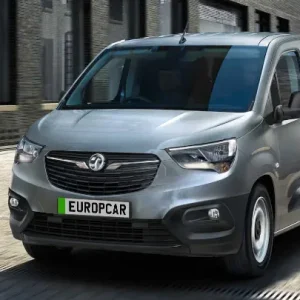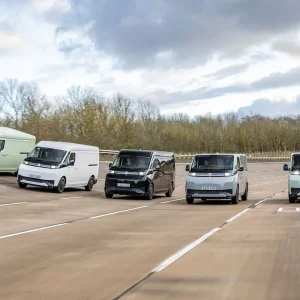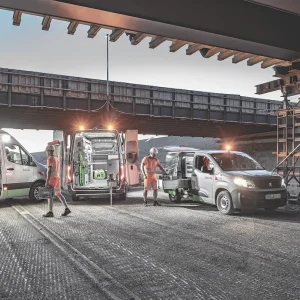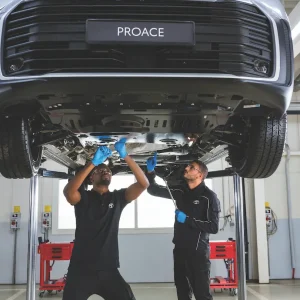Last year, according to figures from the Society of Motor Manufacturers and Traders, 375,687 new light commercial vehicles were registered in the UK – 1% up on 2015’s 371,830. Of these, 294,519 new LCVs in 2016 were registered to fleets, which represents a 2.5% improvement compared with the previous 12 months. Fleet is a growing market.
To capture that market, manufacturers are offering a wider choice of vehicle solutions, with some brands, for example, providing greater levels of tailoring in return for longer leasing deals. According to the 2016/17 Operational Fleet Insight report released by BT Fleet and the AA earlier this year, which surveyed both fleet managers and drivers: “Greater attention to the market from [light commercial vehicle] manufacturers has allowed for wider choice consideration and allowed fleet managers to attain more bespoke, tailored benefits in return for long-term purchasing or leasing contracts.”
An interest in more focussed, tailor-made LCVs has been noticed by rental and leasing providers too, with Stuart Russell, specialist vehicle director at rental firm Europcar, telling What Van?: “One size doesn’t fit all anymore. It’s not simply about offering flexibility in terms of short-term or long-term rental.
We are also supporting the changing needs of our customers by providing an extensive, bespoke vehicle-fitting service including internal racking, roof racks, towbars, beacons and, for one customer, the provision of a tool box inside each vehicle.”
Furthermore, Russell went on to say that Europcar is noticing a considerable uplift in demand for much more specialist vehicles. These include tippers, dropsides, crew cabs and pick-ups, while the demand for vehicles that comply with Chapter 8 livery standards is also on the up.
Service checklist
Richard Tilden, head of commercial vehicles at leasing firm Lex Autolease, says there has been a significant increase in the awareness and concern for health and safety, especially when it comes to ensuring that drivers are in as little danger as possible.
Mark Lovett, Leaseplan UK’s head of commercial vehicles, agrees, saying there is a great deal more expectation on the leasing companies to support operators with their health and safety.
“We’ve got a lot of customers now that take safety in the workplace extremely seriously and have a zero-harm to workforce policy, and that is extended across to their commercial vehicle drivers as well,” he says. “So we have to make sure that we’ve got products and services in place that will enable us to make sure that the vehicles are absolutely roadworthy at all times and legally compliant as well.”
So it’s not only the correct vehicles that fleets need to procure from leasing companies, but they also need to make sure that they obtain the necessary services from them too. This includes procuring the correct service, maintenance and repair (SMR) packages from leasing firms.
According to Tilden, customers require more flexible SMR packages to ensure that vehicles stay on the road as much as possible, thus reducing vehicle downtime while improving efficiency and return on investment rates.
“More and more the key issue is becoming vehicle off-road or downtime,” he says. “Customers are requiring more of an HGV-type proposition in terms of service and maintenance, such as out-of-hours servicing and on-site maintenance, so they can be carrying on with their work while the van is being repaired.”
Many fleets rely on leasing companies to not only supply the vehicles they need, but also to ensure that they receive the correct vehicles for those needs. For example, Lex Autolease always works on a consultative basis, meaning that the company works with the fleet manager, ascertains exactly what it is that the fleet needs its vehicles to do, and makes recommendations based on its findings.
Lex’s Tilden tells What Van?: “Our team of engineers gets involved in nearly 75% of the quotes when a customer asks for advice. They will look at the customer’s operation, the operating environment of the vehicle. We would then take it away, select a vehicle that’s suitable, work with our supply chain and send back a recommendation in writing to our customer in terms of what we have heard, what the customer’s requirements were and our recommendation.”
This is an approach that Russell at Europcar recognises. “At Europcar we aim to understand the specific needs of our commercial vehicle customers through our specialist teams at each of our Van Supersite Hubs,” he says. “They work with our customers to plan for their long-term needs, which then enables us to ensure we have the right mix of fleet available in the right locations around the country.”
The future’s electric
What with all the focus on diesel and NOx emissions recently, especially with impending legislation arriving that will make older diesel LCVs more expensive to operate within city centres, electric LCVs are starting to make more sense for fleet managers looking towards their next acquisitions. Indeed, Tilden says that “we’ve moved away from alternative fuels and electric vehicles being a statement to being something that’s actually commercially viable, and we’re seeing whole-life costs benefits on certain sub-2.0t vans over their diesel counterparts.”
Indeed, the figures speak for themselves when it comes to their growing popularity. Although they’re still very much a niche choice, 961 electric LCVs were registered in the UK in 2016, compared with 2015’s 819 registrations, a 17.3% increase year-on-year. However, they are only suitable under certain circumstances.
Tilden, for example, would always counsel his customers to take demo vehicles for at least a week to see if they fitted in around the way the company works. Sometimes, fleets might even be advised not to take so many electric vans as they might have initially wanted. For example, defence firm BAE Systems recently took delivery of 48 new Nissan e-NV200 vans on behalf of Portsmouth naval base, although the company originally wanted more, as Tilden explains: “BAE is a good example, where the customer (out of a fleet of around 100 vehicles) wanted 80 EVs, but when we actually mapped it through in terms of what they do and speaking with the drivers, we de-risked it by recommending that they take 48.”
Lovett from Leaseplan is even more enthusiastic when it comes to electric vehicles, saying that “the time has come now for the electric van to be considered as a very sensible option, particularly now there is less anxiety around range, there is less anxiety around charging infrastructure, and modern battery technology is really making these vehicles very credible alternatives to diesels”. He also went on to highlight the importance of van operators installing their own charging points and implementing a driver education policy on electric vans.
Even though electric LCVs are becoming more viable, there is still some resistance to them. The AA and BT Fleet report stated that “even the slightest inclination of a loss of performance is enough to make the most enthusiastic fleet manager stick with a diesel vehicle for the task. Lack of Government incentives and taxes is also a restrictive factor, and, whilst massively improved, there is still work to be done on the number of available charging stations across the UK.”
Changing times
Before equipping a fleet with LCVs fleet managers should talk to the experts to find out exactly what sort of vehicle will do the job they need it to do quickly, efficiently and cost-effectively. Don’t just go down the same route as always – explore different avenues as these may benefit the fleet in the long term. This is partly because, as Lovett explains, “so much is changing in the LCV arena that the vehicle that may have been right for their purpose three, four, five years ago may not be the same commercial vehicle of choice for their fleet today”. He goes on to say: “We challenge the customers on the way they use their vans today and we work with them to make sure that it’s a really collaborative, almost partnership-like, approach, and say this is what we recommend – do you agree that this particular vehicle is going to be able to do the work that you expect it to do?”





